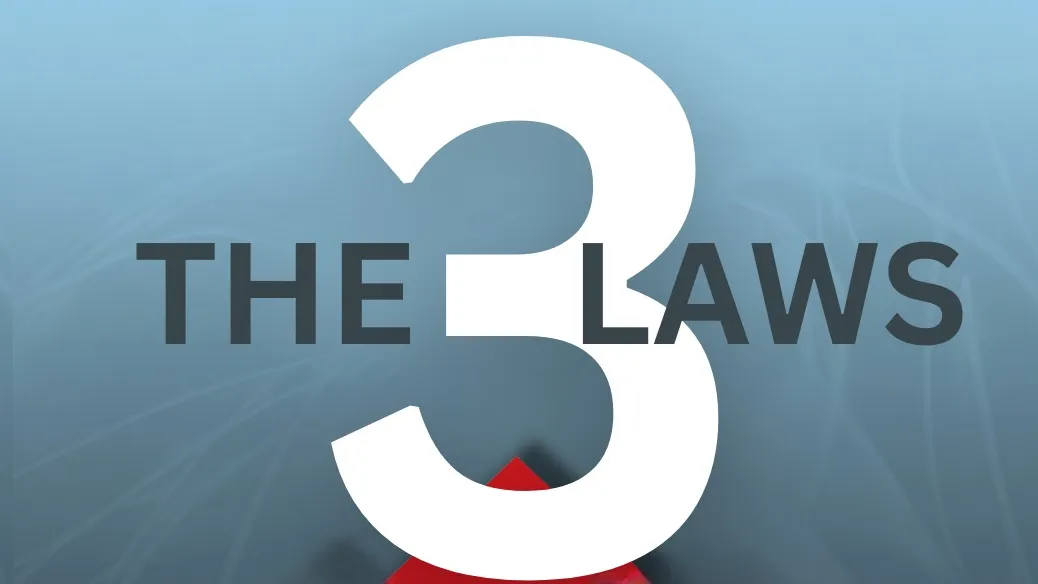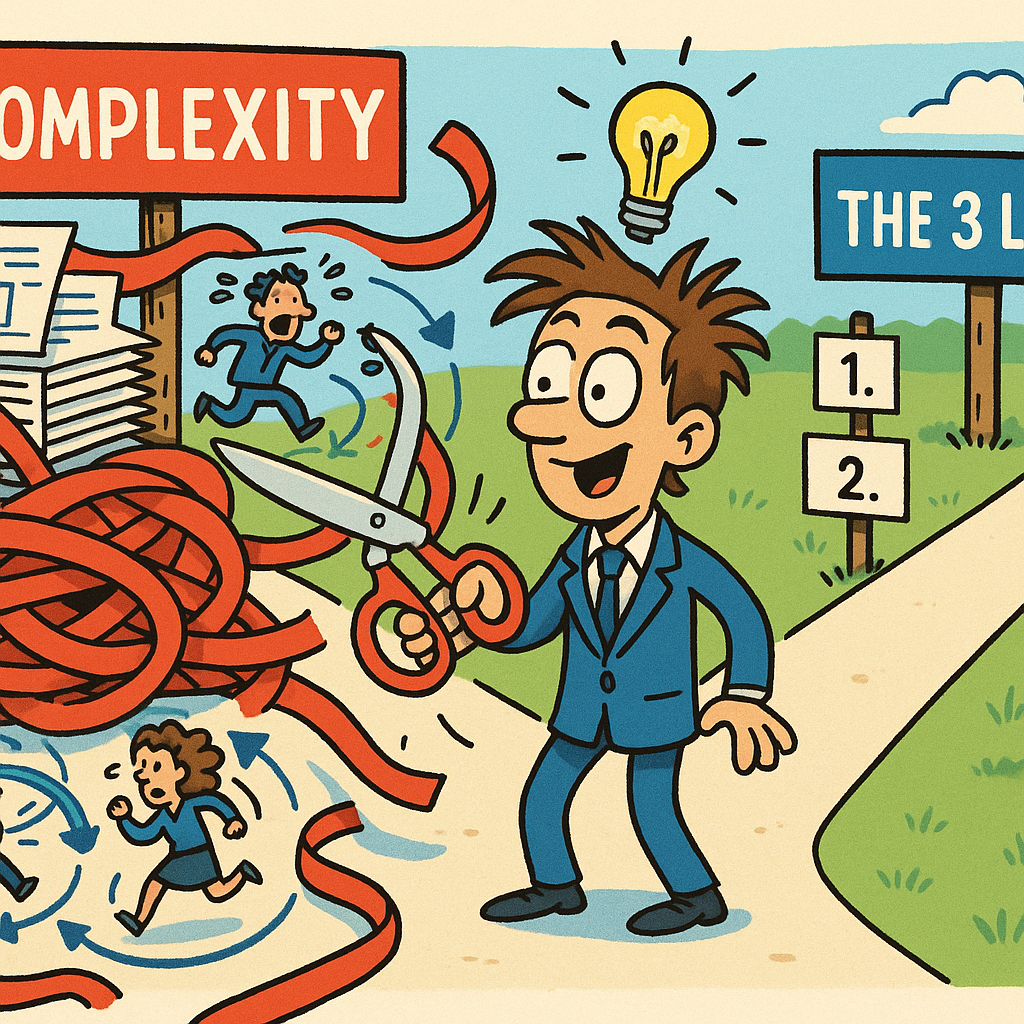The 3 Laws:
Your Flight Plan from Chaos to Clarity

Picture this: You're sitting in yet another meeting about meetings.
The conference room is packed with smart people accomplishing nothing. Your inbox overflows with "urgent" requests that aren't actually important. The simple software update your customer requested six weeks ago is still trapped in approval purgatory. And you're wondering, "How did work become this hard?"
I've been there. After 11 years as a U.S. Air Force C-5 Galaxy instructor pilot, I thought I understood complexity. Flying a 380,000-pound aircraft through storm systems at 40,000 feet? That's complex. But then I entered the corporate world and discovered something shocking: Most business complexity is self-inflicted.
In the cockpit, we had a saying: "Aviate, Navigate, Communicate." Keep it simple, keep it clear, or people die. Yet in business, we do the opposite. We complicate, we obfuscate, we create activity without achievement. We build Rube Goldberg machines to turn on light bulbs.
After leading multiple turnarounds as a CEO and watching brilliant teams fail inside broken systems, I discovered three fundamental laws that separate high-performing organizations from the chaos factories. These aren't complex theories or academic frameworks. They're simple truths that, when applied with discipline, transform how work gets done.
The 3 Laws That Change Everything
Law 1: Simplify Before You Add
Every organization I've worked with has the same disease: Addition Addiction. Problem with communication? Add more meetings. Issue with quality? Add more approval layers. Concerns about oversight? Add more reports, processes, and checkpoints.Here's what actually happens: A client complaint about slow delivery triggers the creation of a "delivery acceleration committee" that meets weekly, requires status reports, and adds three new approval gates. Result? Delivery gets 30% slower.At one company I advised, they had a 312-page manual for submitting expense reports. Three hundred and twelve pages. For receipts. When I asked why, the answer was always the same: "Well, someone once submitted a questionable expense, so we added a control. Then another incident, another control. Then another..."The discipline of Law 1 is this: Before you add anything new, first remove two things that don't work.In aviation, every pound of unnecessary weight burns fuel and reduces range. In business, every unnecessary process burns time and reduces results. The question isn't "What should we add?" It's "What can we delete?"
Law 2: Clarity Before Clever
I once watched a brilliant MBA present a "customer journey optimization framework" that required three training sessions to understand. It had matrices, decision trees, and enough jargon to fill a dictionary. It was intellectually impressive and practically useless.Meanwhile, a competitor was eating their lunch with a simple principle: "Make it easy for customers to buy from us."Clever impresses in conference rooms. Clarity wins in the market.During my Air Force days, our emergency procedures weren't clever—they were crystal clear. When an engine catches fire at 30,000 feet, you don't want a sophisticated decision matrix. You want simple, unambiguous steps that work.
The test I use now is what I call the "Grandmother Rule": If you can't explain your strategy, process, or product to your grandmother in 60 seconds, it's too complicated. Not because grandmothers aren't smart—they're often the smartest people in the room—but because they have zero patience for corporate nonsense.
Your competitive advantage isn't having systems so complex that only you understand them. It's having systems so clear that you can execute faster than anyone else.
Law 3: Results Before Activity
Here's a dirty secret about corporate America: We've confused motion with progress.I recently visited a company where everyone was impressively busy. Calendars packed with meetings. Emails flying at all hours. People working nights and weekends. The energy was palpable. The activity was constant.Their results? Flat revenue for three years.They were like a pilot flying in circles—burning fuel, logging hours, going nowhere.Another organization I worked with tracked different metrics. Not how many meetings people attended or emails they sent, but:
How many customer problems did we solve this week?
How many decisions actually got made?
How many projects moved from idea to implementation?
Guess which company is thriving?
The harsh truth: Your customers don't care how busy you are. They care about results.
From Theory to Transformation
These laws aren't just philosophy—they're operating principles that drive real change. Here's how I've seen them transform organizations:
The Meeting Revolution: One tech company canceled all recurring meetings and demanded that any new meeting have a stated outcome upfront. No outcome, no meeting. Meeting time dropped 60%. Productivity soared.
The Approval Apocalypse: A financial services firm replaced their 12-day, seven-person approval chain with a simple rule: Managers can approve anything under $50K if they own the results. Decision speed increased 400%.The Complexity Audit: A manufacturing company asked every department to identify their three most complex processes. Then they simplified each by 50%. No exceptions. No excuses. Quality improved because problems became visible instead of hidden in complexity.
Why This Matters Now
In my C-5 Galaxy days, we had a term: "flying behind the aircraft." It meant the plane was ahead of your thinking—you were reacting, not commanding. Too many businesses today are flying behind their aircraft, overwhelmed by complexity they created themselves.
The world isn't getting simpler. Technology accelerates. Competition intensifies. Customer expectations rise. You can't control external complexity, but you absolutely can control internal complexity. The companies that thrive won't be those that add more—they'll be those that achieve more with less.
Your Choice Point
Every morning, you face the same choice I faced in that cockpit: Choose clarity or accept chaos. Choose simplicity or surrender to complexity. Choose results or settle for activity.
The 3 Laws aren't magic. They're disciplines. The magic happens when you apply them consistently, especially when adding complexity feels safer or more sophisticated.
Start tomorrow with three questions:
What can I eliminate that adds no value?
What can I clarify that's currently confusing?
What activity can I stop that produces no results?
The Bottom Line
After years of flying massive aircraft through dangerous skies and leading turnarounds in chaotic companies, I've learned this:
Complexity is not sophistication—it's surrender. It's giving up on finding the elegant solution.The most successful organizations aren't those with the most sophisticated systems. They're those with the clearest purpose, simplest processes, and relentless focus on results.You already have everything you need to succeed. The question is whether you'll have the discipline to stop adding and start subtracting, stop impressing and start clarifying, stop moving and start achieving.The 3 Laws are your flight plan from chaos to clarity. The only question left is: Are you ready to take off?
Greg Born is a former U.S. Air Force C-5 Galaxy instructor pilot, CEO of Ainsley Advisory Group, and author of "The 3 Laws: Escape Chaos, Unlock Clarity, Achieve Epic Results." He specializes in helping organizations break free from self-inflicted complexity to achieve breakthrough performance.Ready to implement the 3 Laws in your organization? Download our free Clarity OS Toolkit at the3laws.com and start your transformation from chaos to clarity.
Related Post
Copyright ©️ 2025 Greg Born
